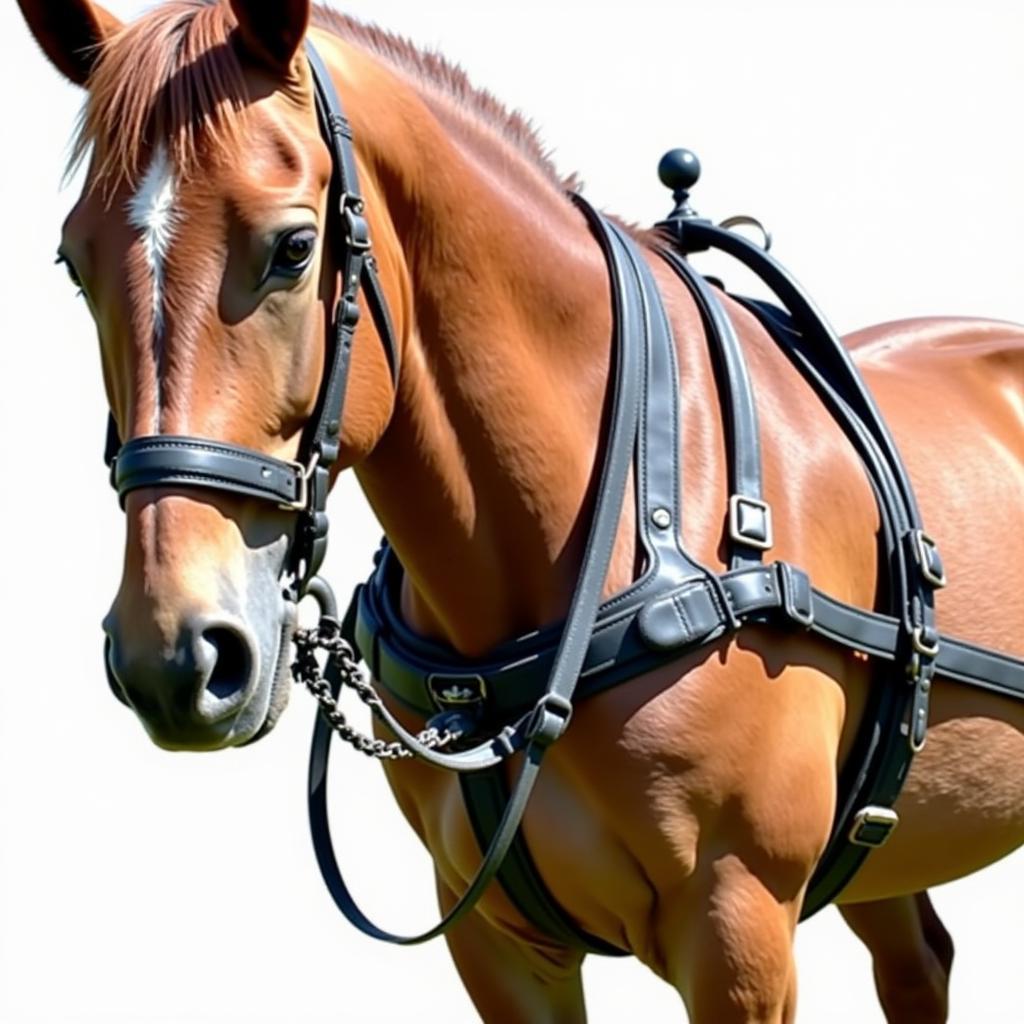Draft horses in harness are a powerful and majestic sight. Whether working the fields or pulling a carriage, these gentle giants are a testament to the enduring partnership between humans and horses. This article delves into the world of draft horses in harness, exploring the history, equipment, and essential care involved in working with these magnificent animals. You’ll gain valuable insights into selecting the right harness, ensuring proper fit, and understanding the different types of work these horses can perform.
Harnessing a draft horse is a skill passed down through generations. It’s more than just placing equipment on the animal; it’s about understanding the horse’s anatomy, behavior, and the specific demands of the task at hand. Choosing the right horse harnesses for sale is crucial for both the horse’s comfort and its ability to work efficiently.
A History of Draft Horses in Harness
Draft horses have been essential partners in agriculture and transportation for centuries. From plowing fields to hauling heavy loads, their strength and endurance have been invaluable. Breeds like the Clydesdale, Percheron, Belgian, and Shire were specifically developed for their power and ability to work in harness. Over time, different harness designs evolved to suit various tasks, from farming to logging and even competitive driving.
Selecting the Right Draft Horse Harness
Choosing the right Draft Horse In Harness starts with understanding the different types available. There are two main categories: breaststrap harnesses and collar and hames harnesses. Breaststrap harnesses are simpler and often used for lighter work, while collar and hames harnesses distribute weight more evenly across the horse’s shoulders and chest, making them ideal for heavier pulling. Within these categories, you’ll find variations designed for specific tasks like plowing, logging, or driving. Finding appropriate draft horse equipment is key to a successful working relationship with your horse.
 Different Types of Draft Horse Harnesses
Different Types of Draft Horse Harnesses
Ensuring a Proper Harness Fit
A properly fitted harness is crucial for the horse’s comfort and performance. An ill-fitting harness can cause chafing, sores, and even restrict the horse’s movement. When fitting a harness, ensure the collar sits snugly but not tightly against the horse’s shoulders, allowing for two fingers to fit between the collar and the horse’s skin. The traces should be adjusted so they pull straight from the hames to the load. Regularly check for signs of wear and tear and replace any damaged draft horse harness parts promptly.
Working Your Draft Horse in Harness
Draft horses can perform a variety of tasks in harness. From plowing and cultivating fields to hauling logs and pulling carriages, their versatility is impressive. Introducing a draft horse to work should be done gradually, starting with lighter tasks and progressively increasing the workload as the horse builds strength and stamina. Clear communication and consistent training are essential for a safe and productive working relationship.
“A well-trained draft horse in harness is a true partner,” says Johnathan Miller, a seasoned draft horse trainer. “It’s about building trust and understanding, not just about power and work.”
Caring for Your Draft Horse Harness
Proper care and maintenance of your draft horse harness will extend its lifespan and ensure the horse’s safety. After each use, clean the harness thoroughly with saddle soap and water, paying particular attention to areas that come into contact with the horse’s skin. Allow the harness to dry completely before storing it in a cool, dry place. Regularly inspect the harness for signs of wear and tear and replace any damaged parts promptly.
“Investing in a quality used draft horse harness for sale can be a great option for beginners,” advises Amelia Carter, an equine veterinarian. “Just make sure it’s in good condition and fits your horse correctly.”
Harnessing a Draft Horse: A Step-by-Step Guide
- Prepare the Horse: Groom the horse thoroughly and ensure its hooves are clean.
- Position the Collar: Place the collar over the horse’s head and ensure it sits comfortably on the shoulders.
- Attach the Hames: Secure the hames to the collar, making sure they are properly aligned.
- Connect the Traces: Attach the traces to the hames and the vehicle or implement.
- Adjust the Back Band: Secure the back band and ensure it fits snugly without restricting movement.
- Check the Fit: Double-check all parts of the harness to ensure a proper fit and free movement.
 Proper Draft Horse Harness Fitting
Proper Draft Horse Harness Fitting
Conclusion
Working with a draft horse in harness is a rewarding experience. By understanding the history, equipment, and proper care involved, you can build a strong and lasting partnership with these magnificent animals. Choosing the right harness, ensuring a proper fit, and providing consistent training are key to a successful and enjoyable working relationship with your draft horse. Remember, finding suitable horses for beginners for sale can greatly enhance your experience.
FAQ
- What is the difference between a breaststrap harness and a collar and hames harness?
- How do I know if my draft horse’s harness fits correctly?
- What are the different types of work draft horses can perform in harness?
- How do I care for my draft horse harness?
- What are the key considerations when selecting a draft horse harness?
- How do I introduce my draft horse to working in harness?
- Where can I find reliable resources for draft horse harness information?
Need assistance? Contact us at Phone: 0772127271, Email: [email protected] or visit us at QGM2+WX2, Vị Trung, Vị Thuỷ, Hậu Giang, Việt Nam. We have a 24/7 customer service team.